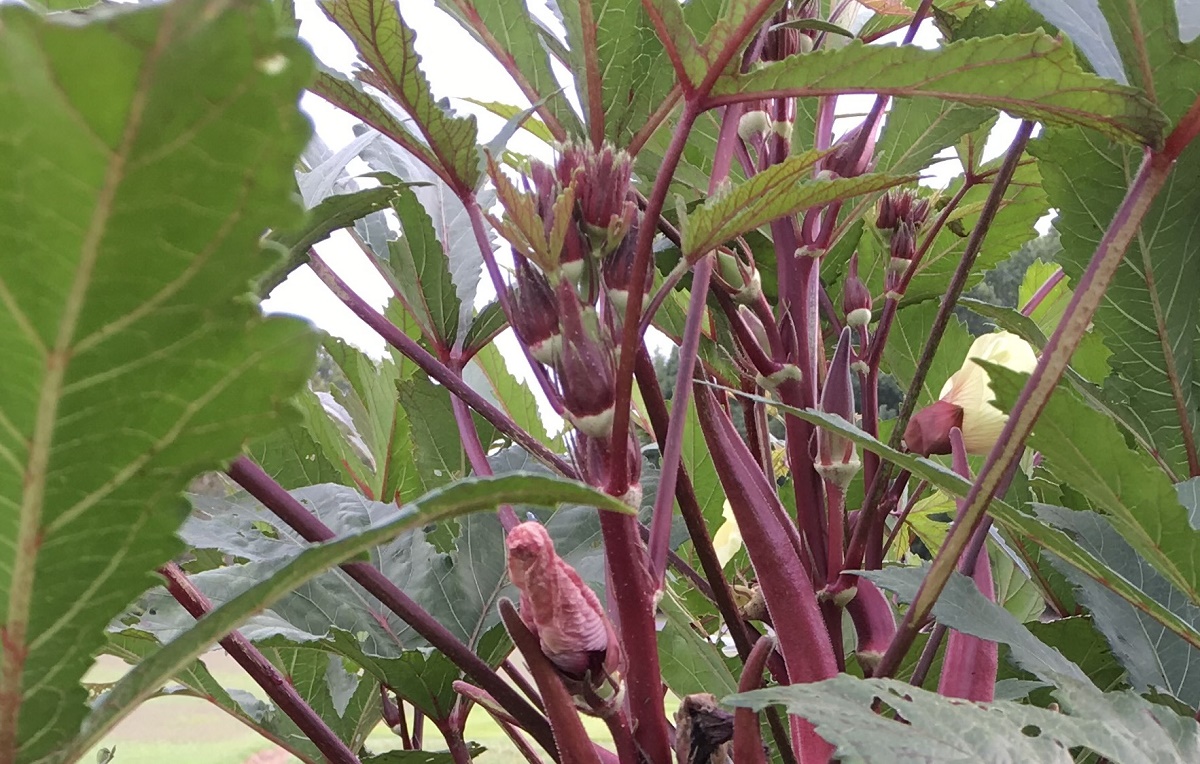
UT Gardens’ September 2021 Plant of the Month
Submitted by Holly Jones and Carson Brown, horticulturists with the UT Gardens, Knoxville, and UT Gardens, Jackson, respectively
Okra (Abelmoschus esculentus) is a summertime staple for many Tennessee farmers and home gardeners. Drive down any local country road in late June through early September and you will probably spot a long row of tall, green branching plants with palmate leaves, creamy yellow flowers and seed pods shaped like thick, pointy fingers, thriving in the blazing summer sunshine. Likely originating from modern day Ethiopia, this close relative of hibiscus and hollyhocks prefers hot weather, high humidity and a relatively long growing season, which makes it a perfect fit for our summertime climate.
The seeds can be sown directly in a prepared garden bed once all danger of frost has passed and the soil temperature has reached 65 degrees F or more. This warm-season annual can also be transplanted after starting indoors, just be sure to hold off on planting out until the air and soil are warm enough. Lean, dry soil conditions may be tolerated once plants are established, but providing a moist, well-drained, fertile growing medium will lead to a bigger harvest. Provide 6-8 hours of direct sunlight and good air circulation to ensure healthy growth and to help prevent powdery mildew, which is a common late season affliction.
Although delicious fried, roasted, grilled, sautéed or pickled, the tender pods are also delicious raw, with hummus or other dip, and sliced in salads. To catch the pods before they become tough, check often and harvest them young. The exact size will vary depending on the variety, but they are generally best harvested when they are between 2-4 inches long. If they have become too mature, the seeds can be cooked like peas. During harvest season, it’s best to pick every other day because allowing the pods to mature on the plant will slow production. The plants can also be cut back midsummer to between 6-12 inches and side dressed with an all-purpose, balanced fertilizer to rejuvenate them for an extended harvest through fall.
Once you have had your fill of eating okra from these high-yielding plants, allow some pods to mature and dry completely on the plant to use as an art supply for elegant and seasonal decorations or cute crafts for your kids. Imagine them as Santa Claus, an angel, a gnome, or an accent for wreaths, or other creative decorations. The flowers are also attractive enough to be grown solely for their ornamental value. Varieties like the All-America Selections winner ‘Candle Fire’ can add beauty and interest to the garden with red stems that can reach to between 4-6 feet tall with abundant seed pods that are also an enticing red color. Although these cylindrical pods with smooth sides take longer than other varieties to become tough, they are best harvested at about 3-4 inches long and with a diameter of about half an inch. This year Candle Fire is on display at both the UT Gardens, Jackson, and the UT Gardens, Knoxville.
‘Jambalaya’ is a choice selection for the culinary garden due to disease resistance, a stocky growth habit and tender green spineless pods. The pods begin appearing a week or so earlier than other varieties at the Helping Hands Kitchen Garden at the UT Gardens, Knoxville. Compact cultivars suited for smaller spaces or raised beds are also available.
The UT Gardens includes plant collections located in Knoxville, Crossville and Jackson. Designated as the official botanical garden for the state of Tennessee, the collections are part of the UT Institute of Agriculture. The Gardens’ mission is to foster appreciation, education and stewardship of plants through garden displays, educational programs and research trials. The Gardens are open during all seasons and free to the public. For more information, see the Gardens website.